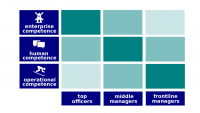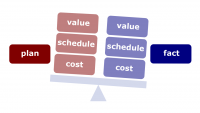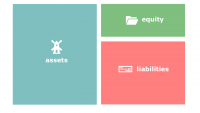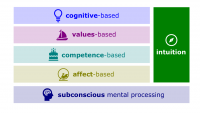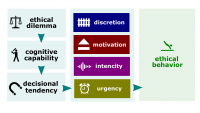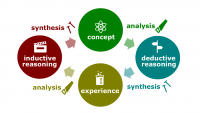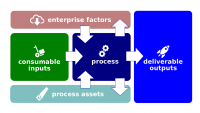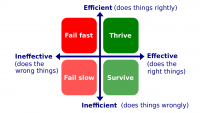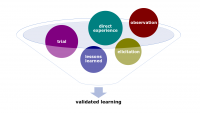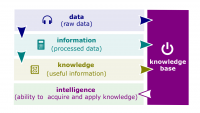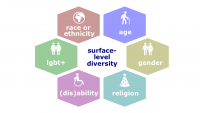OB introductory concepts
OB introductory concepts are those concepts that are related to the core of the organizational behavior science. The concepts below are taken from Organizational Behavior by Robbins and Judge (17th edition); Septem Artes Administrativi served as the primary source of illustrations.
Recitals
- Manager. An individual who achieves goals through other people.
- Organization. A consciously coordinated social unit, composed of two or more people, that functions on a relatively continuous basis to achieve a common goal or set of goals.
- Planning. A process that includes defining goals, establishing strategy, and developing plans to coordinate activities.
- Organizing. Determining what tasks are to be done, who is to do them, how the tasks are to be grouped, who reports to whom, and where decisions are to be made.
- Leading. A function that includes motivating employees, directing others, selecting the most effective communication channels, and resolving conflicts.
- Controlling. Monitoring activities to ensure they are being accomplished as planned and correcting any significant deviations.
- Organizational behavior. A field of study that investigates the impact individuals, groups, and structure have on behavior within organizations, for the purpose of applying such knowledge toward improving an organization's effectiveness.
- Systematic study. Looking at relationships, attempting to attribute causes and effects, and drawing conclusions based on scientific evidence.
- Evidence-based management. The basing of managerial decisions on the best available scientific evidence.
- Intuition. An instinctive feeling not necessarily supported by research.
- Psychology. The science that seeks to measure, explain, and sometimes change the behavior of humans and other animals.
- Social psychology. An area of psychology that blends concepts from psychology and sociology to focus on the influence of people on one other.
- Sociology. The study of people in relation to their social environment and culture.
- Anthropology. The study of societies to learn about human beings and their activities.
- Contingency variable. A situational factor that moderates the relationship between two or more variables.
- Positive organizational scholarship. An area of organizational behavior research that concerns how organizations develop human strengths, foster vitality and resilience, and unlock potential.
- Ethical dilemma. A situation in which individuals are required to define right and wrong conduct.
- Model. An abstraction of reality, a simplified representation of some real-world phenomenon.
- Input. A variable that leads to processes.
- Process. An action that individuals, groups, and organizations engage in as a result of inputs and that leads to certain outcomes.
- Outcome. A key factor that is affected by some other variables.
- Task performance. The combination of effectiveness and efficiency at doing core job tasks.
- Organizational citizenship behavior. Discretionary behavior that contributes to the psychological and social environment of the workplace.
- Withdrawal behavior. The set of actions employees take to separate themselves from the organization.
- Productivity. The combination of the effectiveness and efficiency of an organization.
- Effectiveness. The degree to which an organization meets the needs of its clientele or customers.
- Efficiency. The degree to which an organization can achieve its ends at a low cost.
- Organizational survival. The degree to which an organization is able to exist and grow over the long term.
Diversity
- Diversity. The extent to which members of a group are similar to, or different from, one another.
- Organizational demography. The degree to which members of a work unit share a common demographic attribute, such as age, sex, race, educational level, or length of service in an organization, and the impact of this attribute on turnover.
- Workforce diversity. The concept that organizations are becoming more heterogeneous in terms of gender, age, race, ethnicity, sexual orientation, and other characteristics.
- Surface-level diversity. Differences in easily perceived characteristics, such as gender, race, ethnicity, age, or disability, that do not necessarily reflect the ways people think or feel but may activate certain stereotypes.
- Deep-level diversity. Differences in values, personality, and work preferences that become more important for determining similarity as people get to know each other.
- Discrimination. Noting of a difference between things; often we refer to unfair discrimination, which means making judgments about individuals based on stereotypes regarding their demographic group.
- Biographical characteristic. A personal characteristic -- such as age, gender, race, and length of tenure -- that are objective and easily obtained from personnel records. These characteristics are representative of surface-level diversity.
- Positive diversity climate. In an organization, an environment of inclusiveness and an acceptance of diversity.
- Professional ability. An individual's capacity to perform the various tasks in a job.
- Intellectual ability. An individual's capacity to do mental activities -- thinking, reasoning, and problem solving.
- General mental ability. An overall factor of intelligence, as suggested by the positive correlations among specific intellectual ability dimensions.
- Physical ability. An individual's capacity to do tasks that demand stamina, dexterity, strength, and similar characteristics.
- Diversity management. The process and programs by which managers make everyone more aware of and sensitive to the needs and differences of others.


